
|
|
|
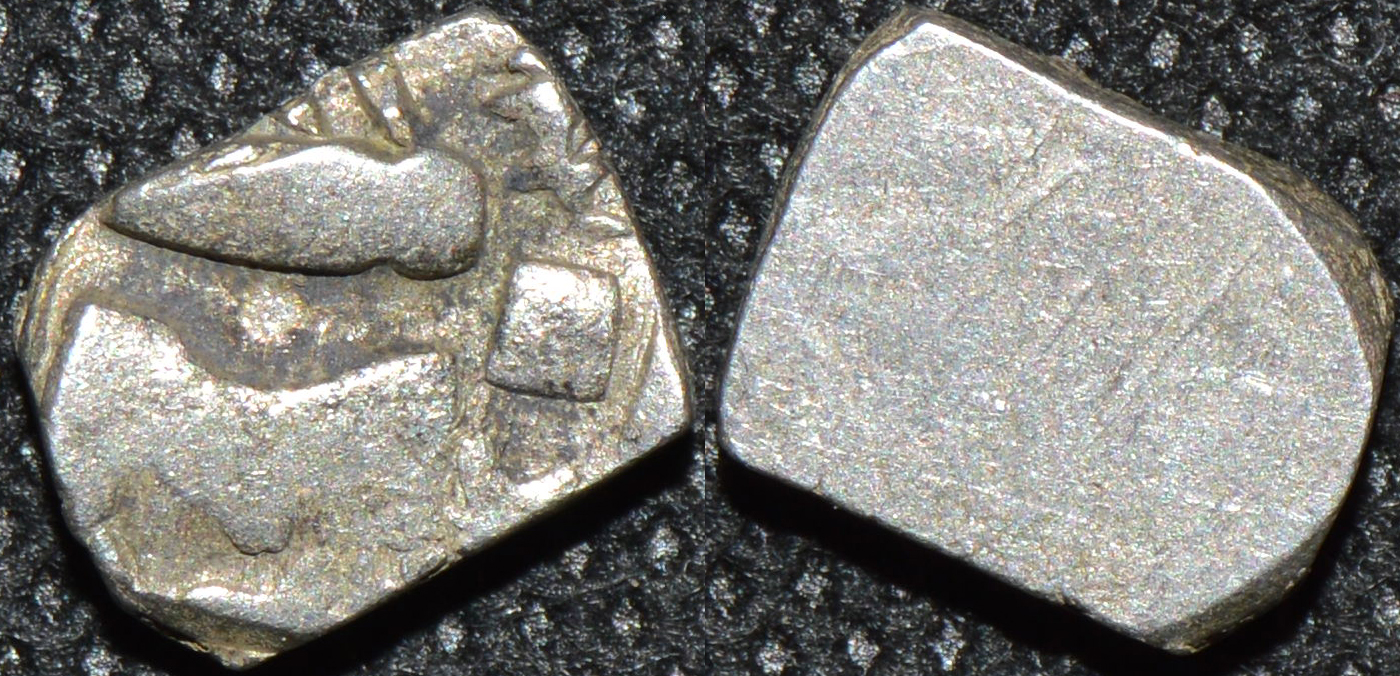
|
Surasena janapada, Silver 1/2 karshapana, c. 4th Century BCE
Weight: 1.76 gm. Dimensions: 11 x 8 mm Die axis: n.a.
Stylized fish over stylized lion right, ancillary symbols at right /
Blank
Reference: Rajgor --- (unlisted), van't Haaff --- (unlisted), Tandon new type B |
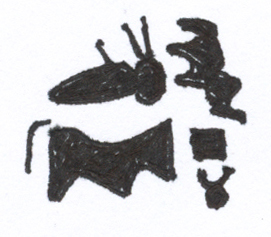 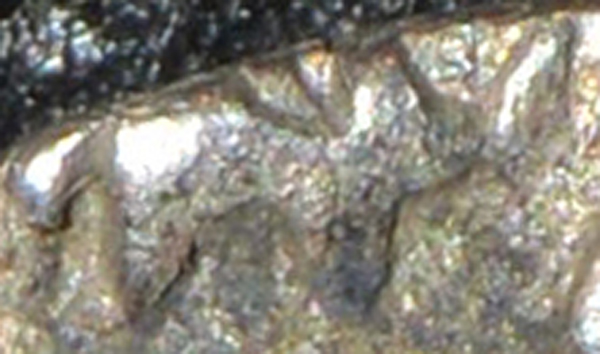
The Surasena janapada was located in western Uttar Pradesh, with its capital at Mathura. The usual coins from
Surasena feature what appear to be a "fish" over a "lion," with added taurines, crescents and dots. Mitchiner
assigned these coins to the Avanti janapada, but Rajgor and van't Haaff assign them to Surasena.
This coin is a new type not seen
in any of the previous catalogues. Eye copy of the design is at left. What is most interesting about this coin is
that it features an elephant as an auxiliary symbol; there were no animals in the auxiliary symbols catalogued by
van't Haaff. Click on the thumbnail at left to see an enlargement of the elephant.
More Surasena coins, including another unique type featuring a bull as an auxiliary symbol, can be seen on the
Surasena page.
| |
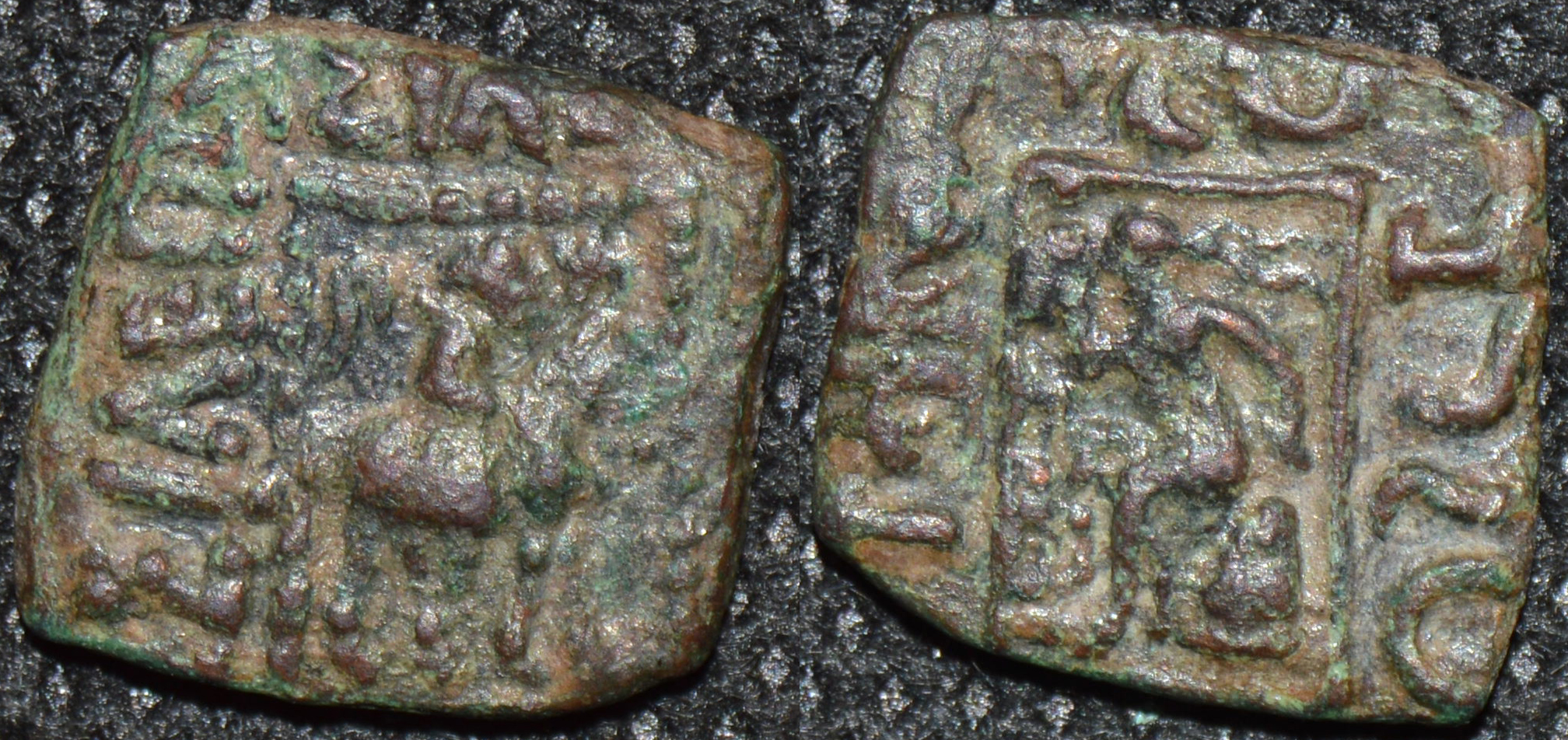
|
Indo-Scythian: Azilises, Copper 1/8 unit, 1st Century BCE
Weight: 0.98 gm. Dimensions: 12 x 11 mm Die axis: 12 o'clock
King mounted on horse right, Kharoshthi ti above, within square border,
Greek legend around: BAΣIΛEΩΣ / BAΣIΛEΩN / MEΓAΛOY // AZIΛICOY
Herakles seated on a rock, holding club, monogram below left,
all within square border, Kharoshthi legend around:
maharajasa / mahatasa / ayilishasa
Reference: MIG --- (unlisted), Sen --- (unlisted) |
|
A previously unknown denomination of an attractive series of copper coins issued by Azilises some time in the middle of the 1st
Century BCE. Senior had previously recorded the full unit, the half and the quarter; this coin adds the eighth unit to the list.
The type is unusual because the Kharoshthi legend on the reverse leaves out the expected
rajarajasa, which would be the translation of the BAΣIΛEΩN (King of Kings) seen on the obverse.
Examples of all four denominations of the type can be seen on the Azilises page.
|
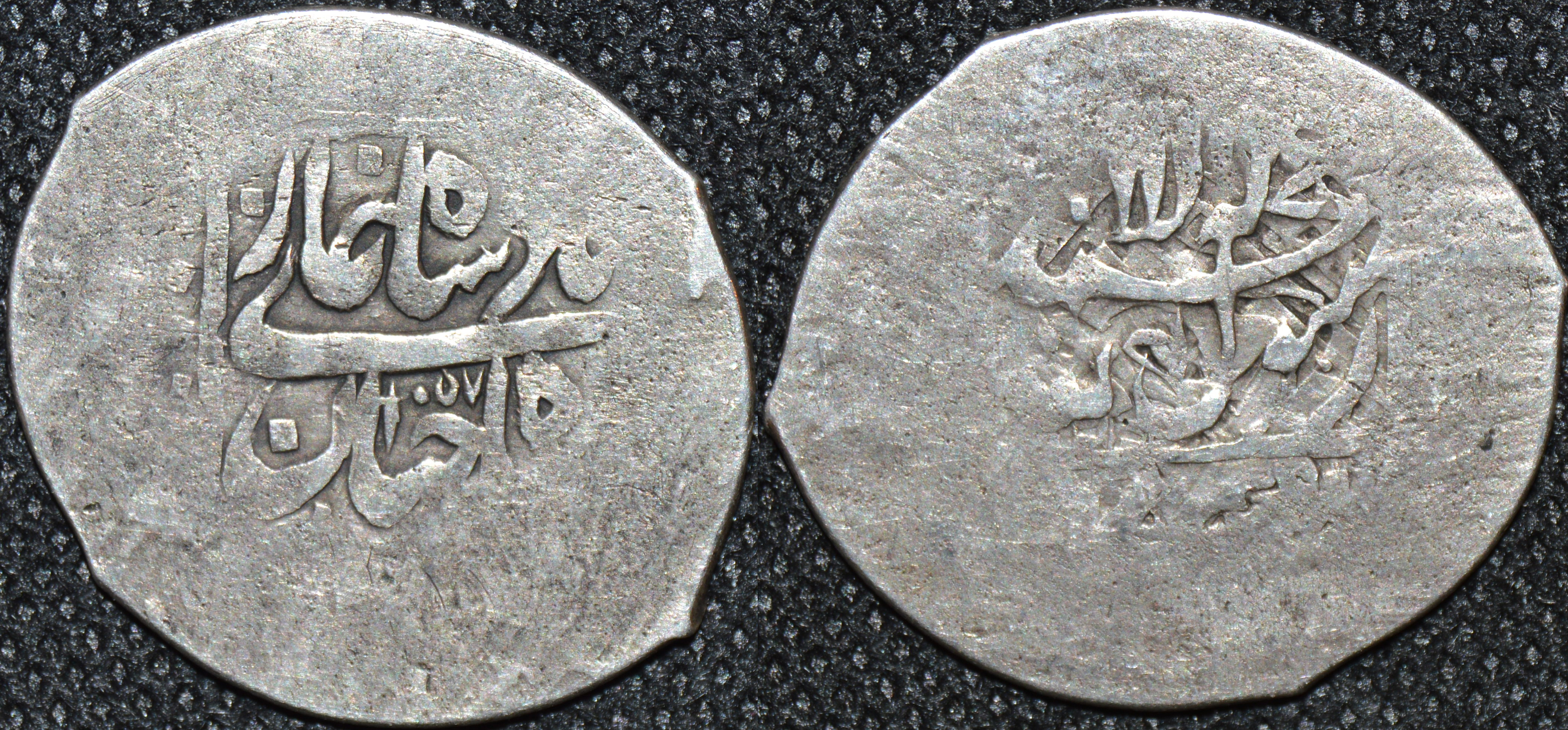
|
Mughal: Shah Jahan (Shahab-ud-din Muhammad Khurram), 1628-58,
Silver khani or shahrukhi, Balkh
Weight: 4.27 gm. Diameter: 25 mm Die axis: 11 o'clock
Legend shah jahan badshah ghazi, with AH date 1057 =1647-48 /
Legend, Kalima
Ref: KM 220.1 type but dated |
|
A most interesting coin, discovered only in the 1990s and providing confirmation of textual accounts of Shah
Jahan's campaign in Balkh. Those accounts have been identified by Shailendra Bhandare in a very interesting paper entitled "Numismatic Reflections on
Shahjahan's Balkh Campaign - 1646-47" to appear in Numismatic Digest, Vol. 39 (2015), and shed light on the conservatism we see in coinage.
The principal source quoted by Bhandare is the Padshahnama of Abdul Hamid Lahori. Shah Jahan mounted his campaign in 1646 at the invitation of the
deposed Khan of Bukhara, who controlled Balkh at the time, and his forces were able to seize Balkh and its substantial treasury with ease in July of that year.
However, the difficulties of maintaining an occupying force so far from the empire, in a place much colder than the Indian troops were used to, and facing constant
harassment at the hands of the large numbers of Uzbek partisans, forced the Mughal army to reach a truce and withdraw by October 1647. Thus the occupation
lasted just over a year.
Given that the Mughal occupation was so short, there was a question of whether they ever issued coins in Balkh. But it is quite certain from Lahori's account that
coins were indeed issued and this coin provides tangible proof of that. Apparently the first coins issued were mohurs and rupees, but the rupees did not find
acceptance because they did not conform to the
roughly 4 gm standard of the local coinage. As a result, Lahori tells us that khanis of that weight, in which copper would be mixed with the silver, would be struck
and exchanged at a rate of four to a rupee. These khanis are what we call today shahrukhis, of which this coin is a great example. The coin is dated AH 1057.
There were other coins dated 1056, and undated ones, three of which can be seen on the Shah Jahan page.
|
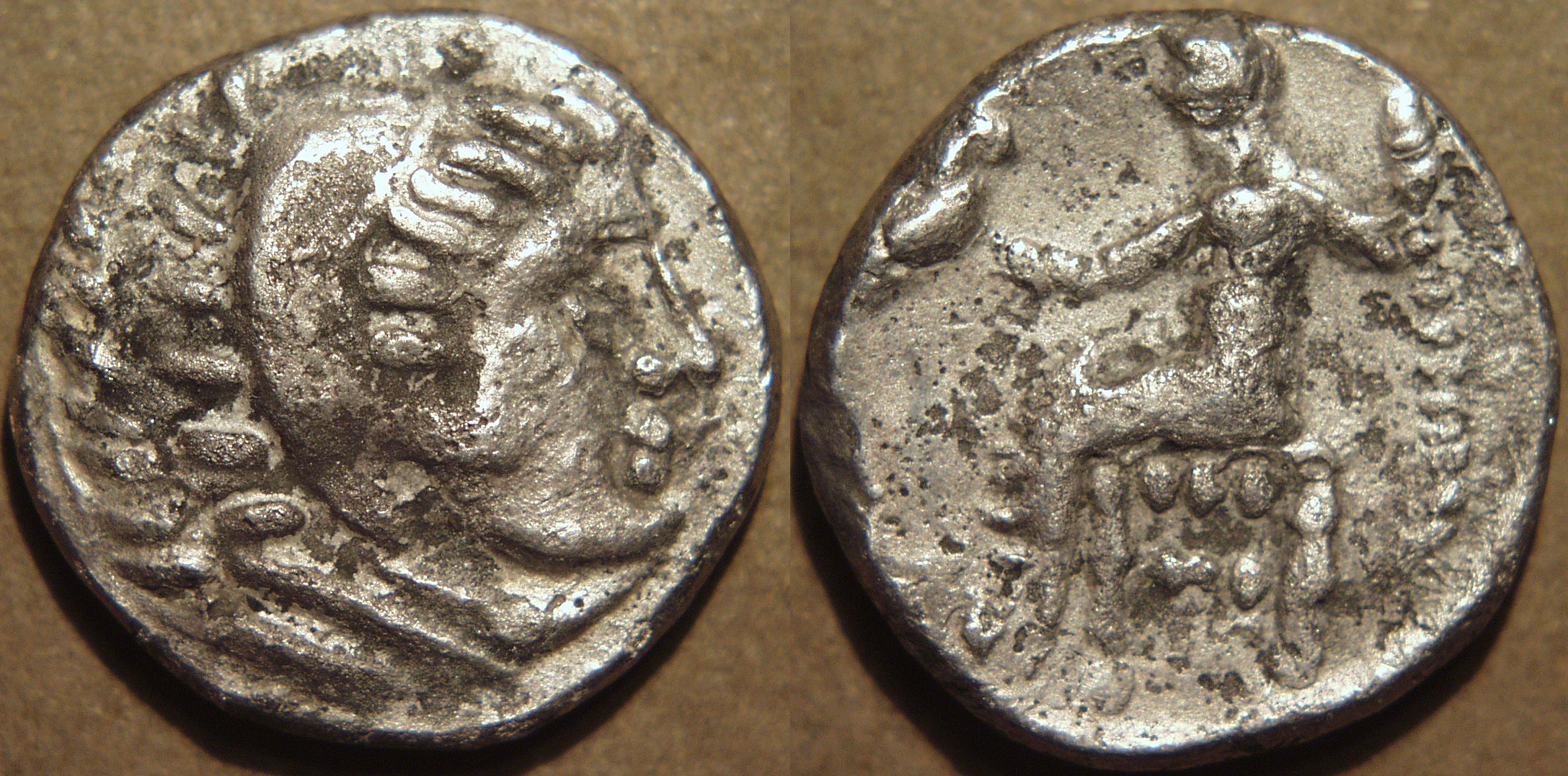
|
Arachosia
Imitation of Alexander III of Macedonia
Silver Tetradrachm, 4th-3rd century BCE
Weight:16.10 gm., Diam: 26 mm., Die axis:3h
Head of Herakles (Alexander ?) right, wearing lion head-dress, dotted border around/
Zeus enthroned left, holding eagle in outstretched right hand, scepter in left hand |
|
This coin appears to belong to a hoard of 200+ coins found near Quetta in 2001. The hoard was first discussed by
Houghton and Lorber in Seleucid Coins, Part I, pp. 483-486 and then published by Richard P. Miller: "East Arachosia (Quetta) Hoard, 2002" in Oliver D. Hoover, Andrew Meadows and Ute
Wartenberg-Kagan (eds.), Coin Hoards. Vol. X. Greek Hoards. Royal Numismatic Society-American Numismatic Society, New York, 2010. The hoard contained coins ranging in date from the late 4th
to the late 3rd century BCE, indicating that it had been buried perhaps in 206 BCE when the Seleucid king Antiochus III passed through the area on the way back from his expedition into
Bactria. About 30% of the coins in the hoard consisted of these very crude silver tetradrachms imitating the coins of Alexander the Great. Many of the Greek kingdoms in this period issued
coins of this type (for an example: see this), but these crude types issued in Eastern Arachosia (the Quetta area) were unknown until the discovery of
this hoard. This area had been ceded by the Seleucids to Chandragupta Maurya, but perhaps the apparatus of the Mauryan state did not pentrate it deeply enough and the need for
coinage may have been felt. Greek soldiers in the area would have been comfortable with coins that looked roughly like the ones they were used to, so it is quite likely that these coins
were issued primarily for circulation in Greek communities. This coin, while not published by Miller, appears to be struck from the same dies as Miller 145. (My thanks to Waleed Ziad for
bringing these coins to my attention, and for helpful discussions.)
Another coin from the hoard can be seen on the pre-Seleucid page.
|
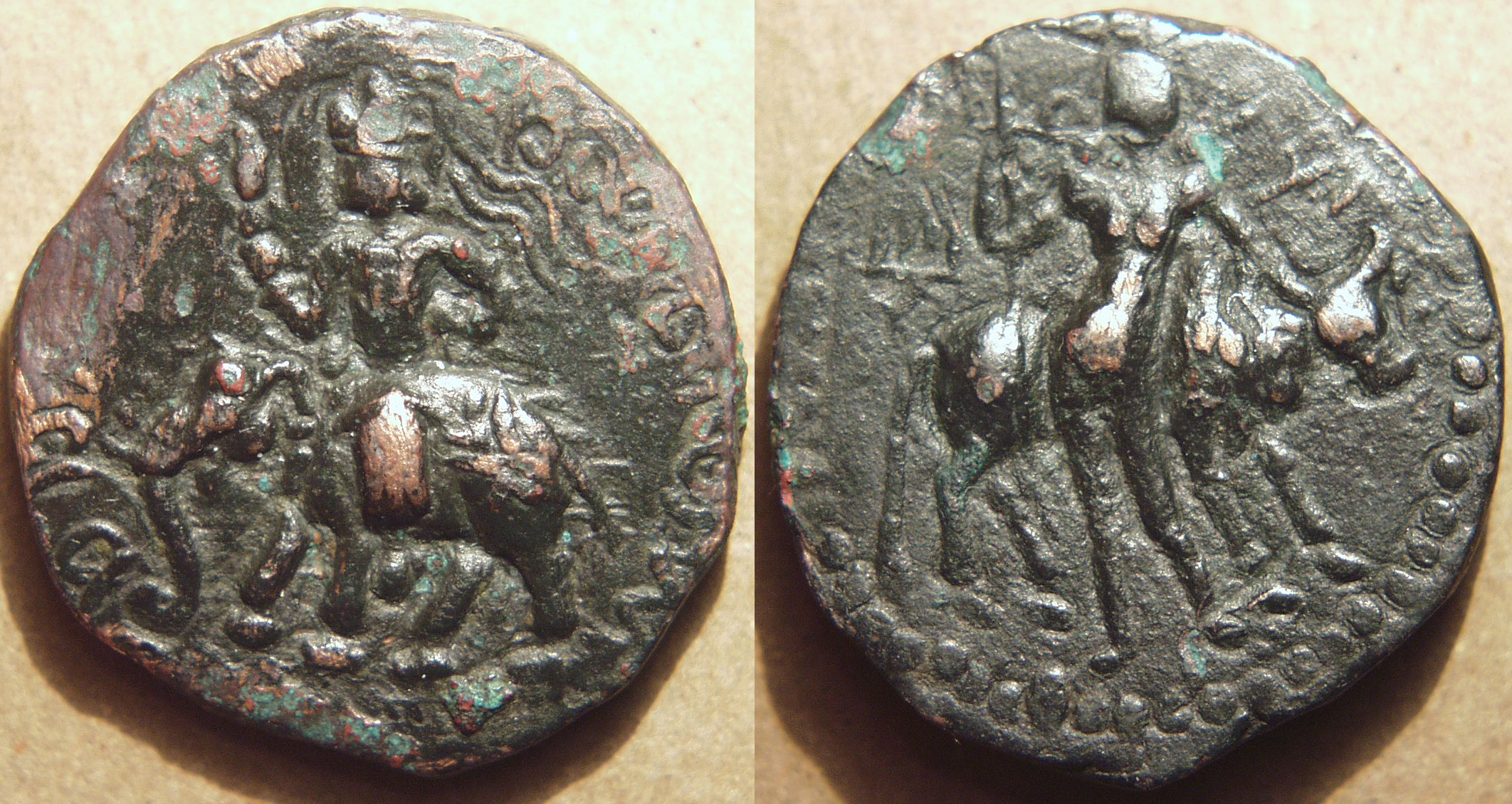
|
Kushan: Huvishka AE tetradrachm, c. 155-190 CE
Weight: 11.16 gm., Diam: 25 mm., Die axis: 12 h
King riding elephant left, holding sceptre in front of face, Bactrian legend around,
Oesho (Siva) standing facing, Bull Nandi behind facing right, dotted border,
Kharoshthi legend at right: yodhavade
Reference: unpublished
|
|
A previously unpublished coin type that appeared in a recent auction. It is remarkable in that no previously known coin of Huvishka included a bull to accompany Oesho (Siva).
In fact, the representation of Oesho on this coin is very like the representation on coins of Huvishka's grandfather, Vima Kadphises, whose coins can be seen on the
Vima Kadphises page. But Kanishka and, as far as we knew up to now, Huvishka, had never included a bull
when representing Oesho. Huvishka's successor Vasudeva I, did include the bull with Oesho, but on his coins the
bull always faces left.
More coins of Huvishka can be seen on the Huvishka page.
|
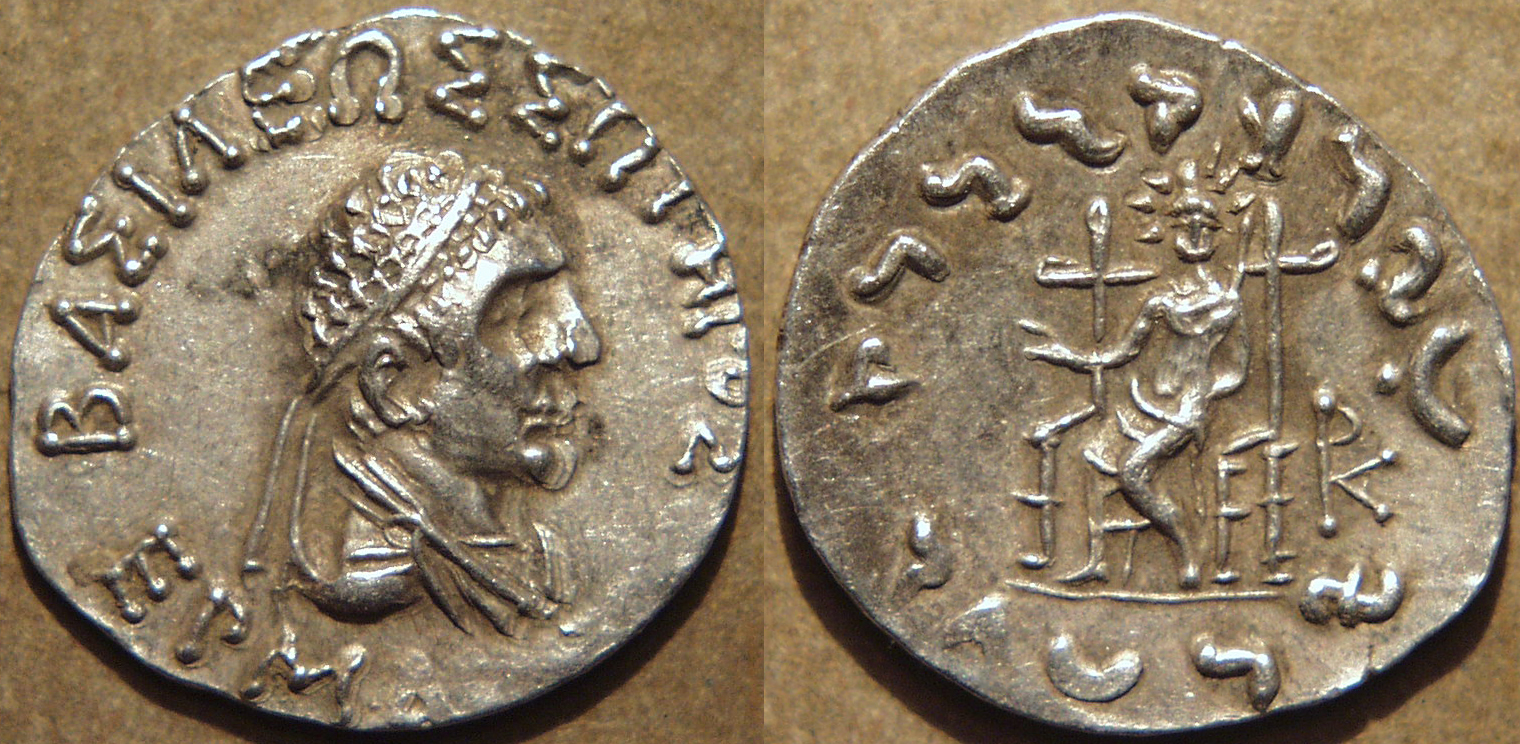
|
Indo-Greek: Hermaios Silver drachm, c. 90-70 BCE
Weight: 2.47 gm. Diameter: 19-17 mm Die axis: 12h
Bare-headed, diademed bust of king right, Greek legend around:
BAΣIΛEΩΣ ΣΩTHPOΣ EPMAIOY
(Basileos Soteros Hermaiou ... of King Hermaios, the Saviour)
Zeus enthroned three-quarters left, holding sceptre in left hand
and bestowing blessing with right hand,
Kharoshthi legend around: maharajasa tratarasa / heramayasa
Reference: MIG 415 var, Bop 3 var
| |
A previously unpublished variety that features a monogram well-known in the Indo-Greek series,
but previously unknown for Hermaios. This PKA monogram was last used by Antialcidas on his Zeus-reverse type ... a type with a reverse design corresponding
to this Hermaios issue. It suggests that, at least in the area where that monogram was used, Hermaios succeeded Antialcidas. The similarity of execution on this
coin with some coins featuring the PKB monogram seen on the first drachm on the Hermaios page
suggests also that the PKB monogram replaced the PKA monogram.
More coins of Hermaios can be seen on the Hermaios page. Coins of Antialcidas can be seen on
the Antialcidas page.
|
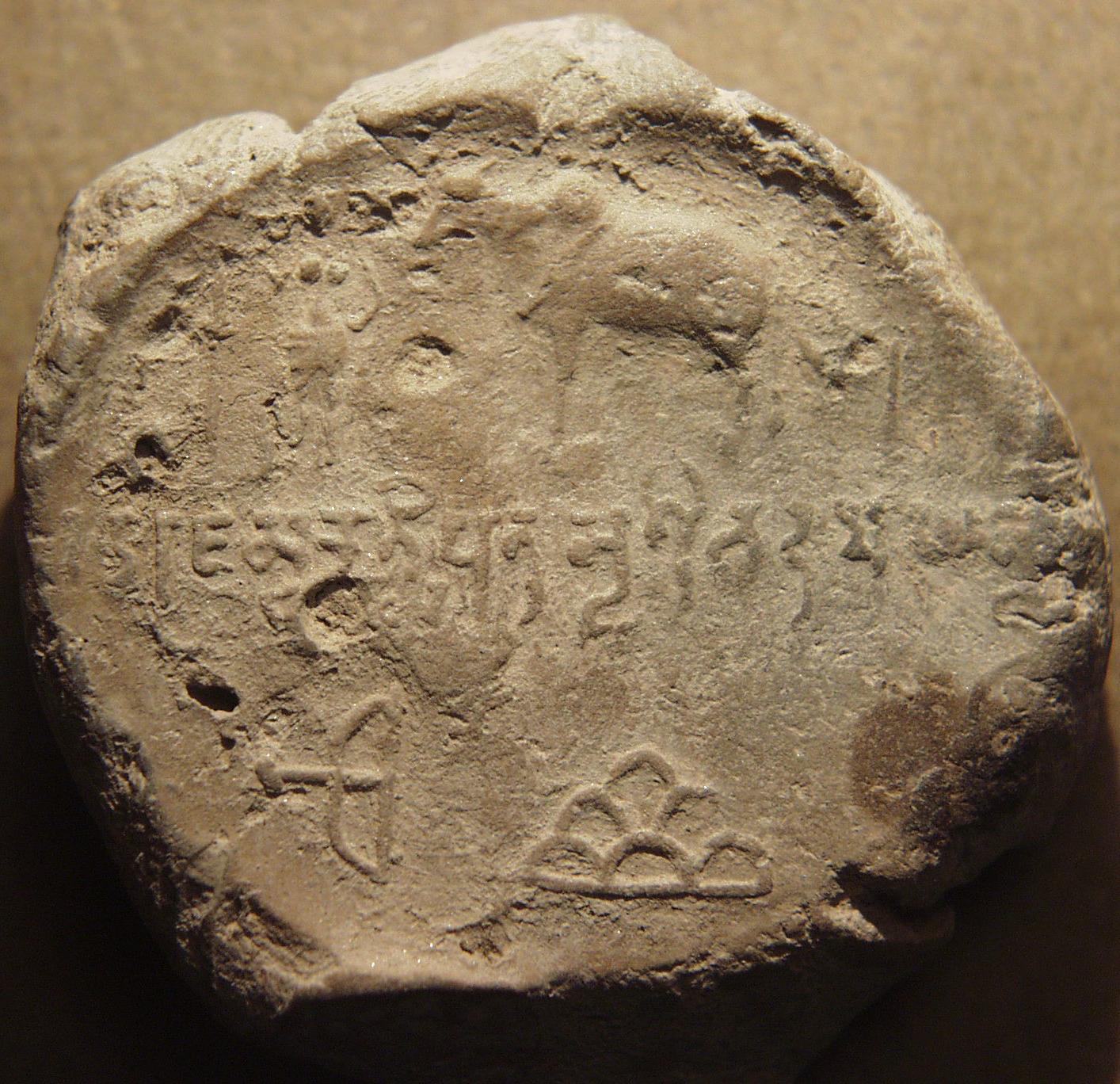
|
Maghas of Kausambi: Bhadramagha, clay sealing, c. 208-214 CE
Weight: 15.78 gm., Diam: 38 mm.
Brahmi legend: maharajasya kotsiputrasya sri bhadramaghasya
Above: Bull left, with goddess standing at left and indistinct symbol at right,
Below: Bow and arrow and six-arched hill or chaitya
Ref: Unpublished
|
|
This featured item is not a coin but a clay sealing or bulla. Bullae are similar to coins in that they typically contain similar information: some symbols of importance and the name of
the person sending the package whose contents are being protected by the seal.
The Maghas of Kausambi appear to be a dynasty which gained control of the area around Kausambi during the period when the Kushan empire was in its decline and the
Gupta empire had not yet emerged. Their original base may have been in Baghelkhand in Madhya Pradesh. Their inscriptions and coins have been found there and in an area from
Allahabad to Fatehpur, corresponding to the area of the ancient kingdom of Vatsa. Bhadramagha was one of the kings in Kausambi. Inscriptions of his with dates ranging from
81 to 87 have been found. There is some debate over which era these dates are in, but if they are in the Kanishka era (which seems logical), the dates of Bhadramagha would
be c. 208-214 CE.
Coins of the Maghas can be seen on the Maghas page.
|
|
|